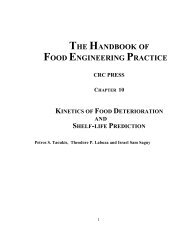A combined discreteâcontinuous model describing the lag phase of ...
A combined discreteâcontinuous model describing the lag phase of ...
A combined discreteâcontinuous model describing the lag phase of ...
Create successful ePaper yourself
Turn your PDF publications into a flip-book with our unique Google optimized e-Paper software.
R.C. McKellar, K. Knight / International Journal <strong>of</strong> Food Microbiology 54 (2000) 171 –180 177<br />
Fig. 8. Replicate simulations using <strong>the</strong> discrete–continuous <strong>model</strong><br />
Fig. 6. Comparison <strong>of</strong> simulated (s) and experimental (d)<br />
(Fig. 2) with three different random seed numbers for normal<br />
growth curves fit with <strong>the</strong> Gompertz function.<br />
(open symbols) and exponential (closed symbols) distributions. t d<br />
values were simulated for a total <strong>of</strong> 20 wells at each <strong>of</strong> 1, 2, 4, 8,<br />
16 or 32 cells per well, with tL<br />
and S.D.<br />
L<br />
values taken from trial A<br />
(Table 1).<br />
simulated) using a non-linear curve fitting routine,<br />
while <strong>the</strong> symbol tL<br />
refers to <strong>the</strong> mean individual cell<br />
<strong>lag</strong> times determined using <strong>the</strong> Bioscreen.<br />
or an exponential (Baranyi, 1998) distribution for 20<br />
The influence <strong>of</strong> <strong>the</strong> S.D. at constant t on <strong>the</strong> l replicate wells each containing 1, 2, 4, 8, 16 or 32<br />
L<br />
L<br />
is shown in Fig. 7. When <strong>the</strong> S.D. is small (open cells. A different random number seed was used for<br />
L<br />
circles) <strong>the</strong> adaptation is rapid, as all <strong>the</strong> cells adapt each replicate simulation. tL and S.D.<br />
L<br />
values (nor-<br />
at approximately <strong>the</strong> same time. As <strong>the</strong> S.D. L<br />
mal distributions) were taken from trial A in Table 1,<br />
increases to a maximum (open triangles), <strong>the</strong> number and tL<br />
values for <strong>the</strong> exponential distributions were<br />
<strong>of</strong> cells adapting earlier than <strong>the</strong> majority increases. adjusted lower in order to separate <strong>the</strong> two data sets.<br />
These cells quickly dominate, and <strong>the</strong> result is a Fig. 8 shows that, with an exponential distribution,<br />
shorter l.<br />
<strong>the</strong> td<br />
values deviate from linearity when <strong>the</strong> number<br />
The influence <strong>of</strong> distribution type was also ex- <strong>of</strong> cells per well ,4. Mean individual cell td<br />
values<br />
amined. Replicate simulations were performed with (1 cell per well) varied considerably depending on<br />
<strong>the</strong> discrete–continuous <strong>model</strong> using ei<strong>the</strong>r a normal <strong>the</strong> random number seed. In contrast, simulations<br />
using normal distributions were linear over <strong>the</strong> whole<br />
range <strong>of</strong> cell numbers, and random number seed had<br />
little apparent effect.<br />
4. Discussion<br />
Fig. 7. Effect on S.D.<br />
L<br />
on apparent population <strong>lag</strong> <strong>phase</strong> duration<br />
(l), where S.D.<br />
L<br />
is: 0.0 (s); 0.3 (d); 0.6 (h); 0.9 (j); and 1.2<br />
(^).<br />
A discrete–continuous <strong>model</strong> has been developed<br />
which improves our understanding <strong>of</strong> <strong>the</strong> behavior <strong>of</strong><br />
cells during <strong>the</strong> period <strong>of</strong> adaptation generally referred<br />
to as <strong>the</strong> ‘‘<strong>lag</strong> <strong>phase</strong>’’. In this <strong>model</strong> <strong>the</strong> <strong>lag</strong><br />
<strong>phase</strong> is described by two parameters, <strong>the</strong> mean<br />
individual cell <strong>lag</strong> time, t<br />
L, and <strong>the</strong> standard deviation<br />
<strong>of</strong> <strong>the</strong> variation between tL<br />
values, S.D.<br />
L. When<br />
<strong>the</strong>se two parameters are used with m, N<br />
0, and N<br />
max,<br />
a complete growth curve can be simulated. It should<br />
be noted that a key assumption <strong>of</strong> this <strong>model</strong> is that














